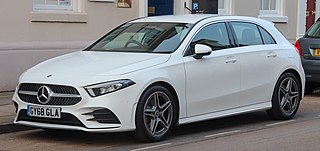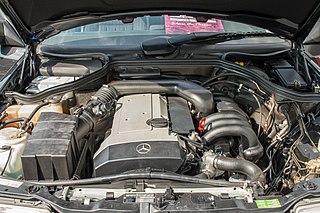
Carl Friedrich Benz, also Karl Friedrich Benz with the same pronunciation, was a German engine designer and automotive engineer. His Benz Patent Motorcar from 1885 is considered the first practical modern automobile and first car put into series production. He received a patent for the motorcar in 1886, the same year he first publicly drove the Benz Patent-Motorwagen.

Gottlieb Wilhelm Daimler was a German engineer, industrial designer and industrialist born in Schorndorf, in what is now Germany. He was a pioneer of internal-combustion engines and automobile development. He invented the high-speed liquid petroleum-fueled engine.

Maybach is a German luxury car brand owned by and a part of Mercedes-Benz AG. The original company was founded in 1909 by Wilhelm Maybach and his son Karl Maybach, originally as a subsidiary of Luftschiffbau Zeppelin GmbH, and it was known as Luftfahrzeug-Motorenbau GmbH until 1999.

The Mercedes-Benz G-Class, sometimes colloquially called the G-Wagen is a four-wheel drive automobile manufactured by Magna Steyr in Austria and sold by Mercedes-Benz. Originally developed as a military off-roader, later more luxurious models were added to the line. In certain markets, it was sold under the Puch name as Puch G until 2000.

The Mercedes-Benz A-Class is a subcompact car produced by the German automobile manufacturer Mercedes-Benz as the brand's entry-level vehicle. The first generation was introduced in 1997, the second generation (W169) in late 2004 and the third generation (W176) in 2012. The fourth generation model (W177), which was launched in 2018, marked the first time the A-Class was offered in the United States and Canada. This fourth generation A-Class is also the first to be offered both as a hatchback (W177) and sedan (V177).
Isdera AG or Ingenieurbüro für Styling, Design und Racing is a privately run German specialty automaker and design service provider based in Saarwellingen, with a design studio in Munich and a design subsidiary in Shanghai, China. The company was founded and formerly based in Leonberg, Germany. Each high-performance sports car is hand-built by a small team of craftsmen, and the only way to purchase a brand new Isdera was to call the CEO directly. Each vehicle is custom built for its original buyer, and a waiting period of twelve months is to be expected.

The C209/A209 Mercedes-Benz CLK-Class is the second generation of the Mercedes-Benz CLK-Class range of mid-size / compact executive coupes produced between 2002 and 2010. The body styles of the range are:

The Mercedes-Benz M104 is a straight-6 automobile engine produced from 1989 through 1999. It has a double overhead cam design with 4 valves per cylinder, and used a crossflow cylinder head. It replaced the M103 and was replaced by the M112 V6 starting in 1997. The bore spacing on all M104 engines is the same as M103 engines.

Horch was a car brand manufacturer, founded in Germany by August Horch & Cie at the beginning of the 20th century.

Daimler-Motoren-Gesellschaft was a German engineering company and later automobile manufacturer, in operation from 1890 until 1926. Founded by Gottlieb Daimler (1834–1900) and Wilhelm Maybach (1846–1929), it was based first in Cannstatt. Daimler died in 1900, and their business moved in 1903 to Stuttgart-Untertürkheim after the original factory was destroyed by fire, and again to Berlin in 1922. Other factories were located in Marienfelde and Sindelfingen.

AB Nyköpings Automobilfabrik (ANA) founded in 1937 was an automobile manufacturer in Nyköping, Sweden that assembled trucks from Chrysler, DeSoto, Plymouth, Fargo and later also Škoda and Standard and from the mid-1950s also Simca. From 1946 they also sold Piper aircraft. The company was founded as a daughter company of Nordiska Kompaniet. During the 1960s the company distributed Massey Ferguson tractors, developing a modified version of the Ferguson hitch called the Swedish Hitch.

The National Technical Museum (NTM) in Prague is the largest institution dedicated to preserving information and artifacts related to the history of technology in the Czech Republic. The museum has large exhibits representing approximately 15% of its total collection. The museum also manages substantial archives consisting of approximately 3,500 linear shelf meters of archival material and about 250,000 books. The museum was founded in 1908 and has been in its current location since 1941.

The Mercedes-Benz T80 is a six-wheeled vehicle built by Mercedes-Benz, developed and designed by Ferdinand Porsche in the late 1930s. It was intended to break the world land speed record, but never made the attempt,due to the project having been overtaken by the outbreak of World War II.
Internal combustion engines date back to between the 10th and 13th centuries, when the first rocket engines were invented in China. Following the first commercial steam engine in 1698, various efforts were made during the 18th century to develop equivalent internal combustion engines. In 1791, the English inventor John Barber patented a gas turbine. In 1794, Thomas Mead patented a gas engine. Also in 1794, Robert Street patented an internal-combustion engine, which was also the first to use liquid fuel (petroleum) and built an engine around that time. In 1798, John Stevens designed the first American internal combustion engine. In 1807, French engineers Nicéphore and Claude Niépce ran a prototype internal combustion engine, using controlled dust explosions, the Pyréolophore. This engine powered a boat on the river in France. The same year, the Swiss engineer François Isaac de Rivaz built and patented a hydrogen and oxygen-powered internal-combustion engine. Fitted to a crude four-wheeled wagon, François Isaac de Rivaz first drove it 100 meters in 1813, thus making history as the first car-like vehicle known to have been powered by an internal-combustion engine.

The Mercedes-Benz GLA is a subcompact luxury crossover SUV manufactured and marketed by Mercedes-Benz over two generations. It is essentially the SUV equivalent of the A-Class, and the smallest SUV marketed by the brand. The production version was revealed in August 2013 ahead of the 2013 Frankfurt Auto Show in September 2013.

The Mercedes-Benz W31 type G4 was a German three-axle off-road vehicle first produced by Mercedes-Benz as a staff/command car for the Wehrmacht in 1934. The cars were designed as a seven-seat touring car or closed saloon, and were mainly used by upper echelons of the Nazi regime in parades and inspections, as they were deemed too expensive for general Army use.

Société Parisienne was a French manufacturer of velocipedes, bicycles and tricycles from 1876. They began limited automobile construction in 1894 and regular light car (voiturette) construction in 1898 or 1899, and they ceased operation in 1903. The vehicles, variously known as Parisienne, Victoria Combination, Eureka, l'Eclair, Duc-Spider and Duc-Tonneau, were manufactured by Société Parisienne E. Couturier et Cie of Paris.

The adoption of plug-in electric vehicles in Sweden is actively supported by the Government of the Kingdom of Sweden. As of December 2021, a total of 355,737 light-duty plug-in electric vehicles have been registered since 2011, consisting of 226,731 plug-in hybrids, 120,343 all-electric cars, and 8,663 fully electric commercial vans.



![Karl Benz, his family and Baron Theodor von Liebieg [cs] in 1894, on a trip from Mannheim to Gernsheim driving a Benz Victoria and a Vis-a-Vis Benz Patent Motor Car Carl Benz, his family and Theodor Baron von Liebieg in 1894, on a trip from Mannheim to Gernsheim, driving a Benz Vis-a-Vis and a Benz Victoria.jpg](http://upload.wikimedia.org/wikipedia/commons/thumb/8/85/Carl_Benz%2C_his_family_and_Theodor_Baron_von_Liebieg_in_1894%2C_on_a_trip_from_Mannheim_to_Gernsheim%2C_driving_a_Benz_Vis-%C3%A0-Vis_and_a_Benz_Victoria.jpg/220px-Carl_Benz%2C_his_family_and_Theodor_Baron_von_Liebieg_in_1894%2C_on_a_trip_from_Mannheim_to_Gernsheim%2C_driving_a_Benz_Vis-%C3%A0-Vis_and_a_Benz_Victoria.jpg)















